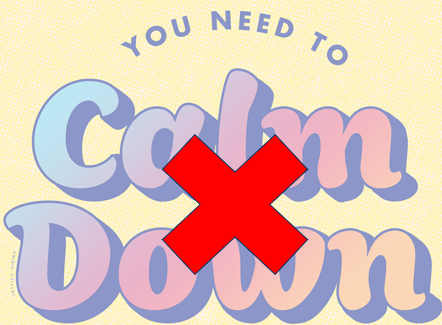Steps to diffuse anger
Imagine you’re faced with a really upset customer, sporting an angry scowl on his face. He’s wagging a finger at you, screaming loudly, “I have been waiting 45 minutes for my prescription!” You might be tempted to say, “Calm down!” However, when you hear the words “calm down,” do you find them calming? Saying “calm down” has probably never made anyone feel calm. To the person receiving those words, “calm down” the tone come across as condescending. Even if you try to sound very subdued and matter-of-fact. If you’re the person saying “calm down” to someone who’s visibly upset or distraught, you’re subtly acting as if you have the upper hand.
When someone is experiencing a lot of emotion, they cannot remain purely rational. During emotionally triggering events, the emotional centers of the brain dominate. So until the emotion subsides, it’s virtually impossible to access reasoning centers of the brain to have a logical conversation.
Listen to the customer - most people who are angry simply want to be heard and have some recognition that they are upset with the pharmacy or the situation they are in. Be patient with the customer, the initial burst of anger you receive will almost always be the most intense. Demonstrate active listening which involves focusing completely on what the customer is saying without interrupting whilst also observing what their body language and non-verbal behaviour tells you. Non-verbal cues to what people are really thinking can sometimes be quite subtle and include things such as movements, gestures, facial expressions or even shifts in the whole body. You may be able to judge from a customer's body language when they are starting to calm down enough for you to be able to talk to them, perhaps noticing how some of the tension has released from their body, or you may detect that their anger is actually more in relation to being upset and worried about a situation, if for example they are starting to look tearful or avoiding eye contact whilst speaking.
Active listening is important as sometimes people, especially when angry, do not say clearly what they think, feel or want and it is only by giving the customer your full attention that you can develop a better understanding. Avoid interrupting with any comments such as "Yes, but..." simply listen and demonstrate you are listening by keeping eye contact and nodding at appropriate intervals until they have finished.
When you fully understand you may find that the customer has simply misunderstood something that was said to them and clarification is all that is required to diffuse the situation. You could try saying something such as, "There seems to be some confusion, may I explain?" or, "It appears I was unclear, let me explain".
Stay calm - behaviour breeds behaviour. If you maintain a calm and positive tone with the customer, this will help to calm them down as it is more difficult to remain angry and continue to shout at someone if they do not respond back in the same manner. It is important for your body language to complement your calm tone. Mehrabian’s 7-38-55 Communication Model , reminds us that 55% of communication comes from our body language, 38% from the tone of our voice and only 7% from the words we speak. Therefore it is recommended to adopt an open body posture, face the person who is speaking, maintain eye contact, avoiding crossing your arms so you do not appear defensive and consider your facial expressions.

